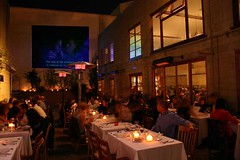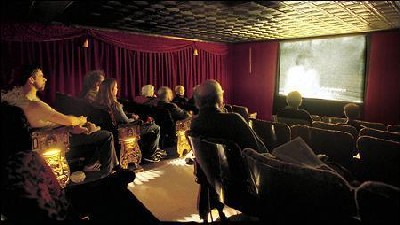Movies and revitalization
I've written about movies and entertainment in the context of commercial districts a fair amount. Not enough time to really write about it but...
1. Foreign Cinema restaurant and "theater" in San Francisco is an updating and upscaling of the "Cinema and Drafthouse" concept. Hard to find movies rather than second run movies, and much more expensive cuisine--a dining experience rather than a place for a pitcher of beer. Moving to this kind of concept, with the food intimately connected with the movie experience (and your being required to eat, and eat expensively) might have been a way for Visions to reposition. Depending on the market, separate cinemas for Bollywood, Spanish-language, and other film genres could probably be quite successful.
 Private dining at Foreign Cinema.
Private dining at Foreign Cinema.2. As Froma Harrop, columnist for the Providence Journal, wrote last week:
Movie theater attendance has been trending downward for years. Everyone has an opinion on the reason. The more popular explanations: People don't go to theaters because they can see movies in their fabulous home-entertainment centers. They stay away because they're angry over the ads and the price for popcorn. The most quoted reason is that the new movies are lousy. No one wants to see them. I have my theory, and it's none of the above. The drop in attendance is not about what's playing in the theaters, the popcorn concession or the facilities at home. It's the theaters, themselves.
One recalls the famous line in "Sunset Boulevard." A guy says to the aging movie star Norma Desmond, "You used to be big." Desmond responds: "I'm still big. It's the pictures that got small." Today, the pictures are still big. It's the movie theaters that got small. Long gone are the Odeons, the Capitols and the Majestics. Their cherubs and lush drapery decay in landfills, and their Mighty Wurlitzers play for the angels. A few survivors have been promoted to "performing-arts centers," but the palace as movie theater is history. Half the fun was sitting in those wedding-cake decors -- which made up for the fact that the other half may have been a clunker like "Bewitched."
Sometime in the 1960s, a developer with no sense of humor decided that the movie-going experience should take place in a box on a shopping strip. The multiplex was born. The multiplexes multiplied, pulling the plug on the Orpheums then holding up the increasingly seedy downtowns. No one really liked going to the warren of cells that now passed for movie theaters, but that was the only place to see a movie -- until the home options arrived. So there is some truth to the idea that DVD players, cable movie channels, TiVo and Netflix have been taking business from movie theaters. But they are competing against the coal-mine shafts at the multiplexes, not the grand old Paramounts.
 Grand Illusion Theater, Seattle. Photo Seattle Times.
Grand Illusion Theater, Seattle. Photo Seattle Times.3. And another reason that people (at least me) don't go to theaters is the talking, which Mark Gauvreau Judge wrote about in an op-ed piece in last Sunday's Post, "Also Playing: Cries & Whispers, Shouts & Backtalk".
___________
This is important for revitalizing commercial districts because you need reasons for people to come to your district. Decently screened movies, movies not showing at Regal 24, and other things to do in the district surrounding the theater are ways to differentiate local commercial districts. By doing things differently, like Foreign Cinema, the Grand Illusion, or the Baghdad Theater in Portland which also has a brew pub (so the beer costs more than at a "Cinema and Drafthouse") you're working on a completely different economic model, with a much higher revenue/per person compared to the other model (note that regular theaters pay upwards of 90% of the admission to the film company, so they make their money on concessions).



0 Comments:
Post a Comment
<< Home